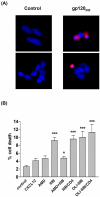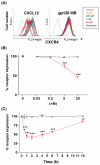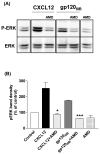Human immunodeficiency virus gp120-induced apoptosis of human neuroblastoma cells in the absence of CXCR4 internalization
- PMID: 16877302
- PMCID: PMC2665038
- DOI: 10.1080/13550280600848373
Human immunodeficiency virus gp120-induced apoptosis of human neuroblastoma cells in the absence of CXCR4 internalization
Abstract
The chemokine receptor CXCR4 functions as human immunodeficiency virus (HIV)-1 coreceptor and is involved in acquired immunodeficiency virus (AIDS) neuropathogenesis. CXCR4 is expressed by most cell types in the brain, including microglia, astrocytes, and neurons. Studies have shown that the HIV envelope protein gp120 binds to neuronal CXCR4 and activates signal transduction pathways leading to apoptosis. However, the natural CXCR4 ligand (CXCL12) has been referred to induce both neuronal survival and death. Here the authors used flow cytometry to determine whether gp120 and CXCL12 differ in their ability to induce CXCR4 internalization in the human neuroblastoma cells SH-SY5Y, which constitutively express CXCR4. As expected, increasing concentration of CXCL12 reduced surface expression of CXCR4 in a time-and concentration-dependent manner. Conversely, gp120IIIB (monomeric or oligomeric, in presence or absence of soluble CD4) did not change CXCR4 membrane levels. Similar results were obtained in a murine lymphocyte cell line (300-19) stably expressing human CXCR4. Nevertheless, gp120IIIB was still able to activate intracellular signaling and proapoptotic pathways, via CXCR4. These results show that gp120IIIB toxicity and signaling do not require CXCR4 internalization in SH-SY5Y cells, and suggest that the viral protein may alter normal CXCR4 trafficking thus, interfering with activation of prosurvival pathways.
Figures




Similar articles
-
gp120 induces cell death in human neuroblastoma cells through the CXCR4 and CCR5 chemokine receptors.J Neurochem. 2000 Jun;74(6):2373-9. doi: 10.1046/j.1471-4159.2000.0742373.x. J Neurochem. 2000. PMID: 10820198
-
Functional CXCR4 receptor development parallels sensitivity to HIV-1 gp120 in cultured rat astroglial cells but not in cultured rat cortical neurons.J Neurovirol. 2002 Oct;8(5):411-9. doi: 10.1080/13550280260422712. J Neurovirol. 2002. PMID: 12402167
-
The chemokine receptor CXCR4 regulates cell-cycle proteins in neurons.J Neurovirol. 2003 Jun;9(3):300-14. doi: 10.1080/13550280390201010. J Neurovirol. 2003. PMID: 12775414 Free PMC article.
-
Chemokine receptor utilization and macrophage signaling by human immunodeficiency virus type 1 gp120: Implications for neuropathogenesis.J Neurovirol. 2004;10 Suppl 1:91-6. doi: 10.1080/753312758. J Neurovirol. 2004. PMID: 14982745 Review.
-
Macrophage activation through CCR5- and CXCR4-mediated gp120-elicited signaling pathways.J Leukoc Biol. 2003 Nov;74(5):676-82. doi: 10.1189/jlb.0503206. Epub 2003 Jul 22. J Leukoc Biol. 2003. PMID: 12960231 Review.
Cited by
-
CXCR7 protein expression in human adult brain and differentiated neurons.PLoS One. 2011;6(5):e20680. doi: 10.1371/journal.pone.0020680. Epub 2011 May 31. PLoS One. 2011. PMID: 21655198 Free PMC article.
-
Co-receptor signaling in the pathogenesis of neuroHIV.Retrovirology. 2021 Aug 24;18(1):24. doi: 10.1186/s12977-021-00569-x. Retrovirology. 2021. PMID: 34429135 Free PMC article. Review.
-
A Novel Role of Proline Oxidase in HIV-1 Envelope Glycoprotein-induced Neuronal Autophagy.J Biol Chem. 2015 Oct 16;290(42):25439-51. doi: 10.1074/jbc.M115.652776. Epub 2015 Sep 1. J Biol Chem. 2015. PMID: 26330555 Free PMC article.
-
Induction of Interleukin-1β by Human Immunodeficiency Virus-1 Viral Proteins Leads to Increased Levels of Neuronal Ferritin Heavy Chain, Synaptic Injury, and Deficits in Flexible Attention.J Neurosci. 2015 Jul 22;35(29):10550-61. doi: 10.1523/JNEUROSCI.4403-14.2015. J Neurosci. 2015. PMID: 26203149 Free PMC article.
-
HIV-1 gp120 and drugs of abuse: interactions in the central nervous system.Curr HIV Res. 2012 Jul;10(5):369-83. doi: 10.2174/157016212802138724. Curr HIV Res. 2012. PMID: 22591361 Free PMC article. Review.
References
-
- Aiuti A, Turchetto L, Cota M, Cipponi A, Brambilla A, Arcelloni C, Paroni R, Vicenzi E, Bordignon C, Poli G. Human CD34(+) cells express CXCR4 and its ligand stromal cell-derived factor-1. Implications for infection by T-cell tropic human immunodeficiency virus. Blood. 1999;94:62–73. - PubMed
-
- Bachis A, Mocchetti I. The chemokine receptor CXCR4 and not the N-methyl-D-aspartate receptor mediates gp120 neurotoxicity in cerebellar granule cells. J Neurosci Res. 2004;75:75–82. - PubMed
-
- Badr G, Borhis G, Treton D, Moog C, Garraud O, Richard Y. HIV type 1 glycoprotein 120 inhibits human B cell chemotaxis to CXC chemokine ligand (CXCL) 12, CC chemokine ligand (CCL)20, and CCL21. J Immunol. 2005;175:302–310. - PubMed
Publication types
MeSH terms
Substances
Grants and funding
LinkOut - more resources
Full Text Sources
Research Materials

